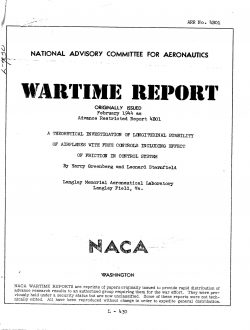naca-wr-l-430
- Version
- 211 Downloads
- 1.62 MB File Size
- 1 File Count
- April 3, 2017 Create Date
- April 3, 2017 Last Updated
A Theoretical Investigation of Longitudinal Stability of Airplanes with Free Controls Including Effect of Friction in Control System

SUMMARY
The relation between_the elevator hinge-moment param-
eters and the control forces for changes in forward speed
and in maneuvers is shown for several values of static
stability and elevator mass balance.
The stability of the short-period oscillations is
shown as a series of boundaries giving the limits of the
stable region in terms of the elevator hinge-moment param-
eters. The effects of static stability, elevator moment
of inertia, elevator mass unbalance, and airplane density
, are also considered. Dynamic instability is likely to
occur if there- is mass unbalance of _the elevator control
system combined with a small re_storing tendency' (high
aerodynamic balance). This instability can be prevented
by a rearrangement of the unbalancing weights which, how-
ever, involves an increase of the amount of weight neces-
sary. It can also be prevented by the addition of
vichus friction to the elevator control system provided
the .ai_rp1ane center of gravity is not behind a certain
critical poéition.
For high. values of the' density_paramelter, which corre-_
spond to high altitudes of flight. the addition of moderate
amounts of viscous friction may be destabilizing even when
the airplane is -statically stable.*- In this_ case, .in-
cre‘asihg the viscous friction makes the oscillation stable
again. The condition in which viscous friction causes
dynamic instability of a statically stable airplane is
limited to a definite range of hinge-moment parameters.
It is shown that, when viscous friction causes increasing
oscillations, solid 'friction will produce steady oscilla-
gigns having an amplitude proportional _to _the amount of
r ction.
INTRODUCTION
-The effects of aerodynamic balance and-mass unbalance
of the elevator on the dynamic stability of the airplane
are discussed in a previous report on control-free sta-
bility (reference 1). It was found theoretically in ref-
erence 1 and verified in flight (reference 2) that, if the '
elevator is too closely balanced aerodynamically and has
a sufficient amount of mass unbalance (which tends to de-
press the elevator), increasing oscillations of short
period may occur. Other flight tests (reference 5)
showed, however, that mass unbalance of the elevator con—
trol system improves the static stability of an airplane,
that is, increases the slope of the curve of stick force
against speed-in level flight and of the curve of stick:firce
against normal acceleration in maneuvers. .Subsequent
work (reference A) has indicated that a control surface
with positive floating tendency (tendency to float against
the relative wind), when used as a rudder, is effective
in improving control-free static stability. A theoreti-
cal analysis (reference 5) Showed that a rudder having a
positive floating ratio may, under the influence of solid
friction in the control system, build up steady oscilla-
tions of the airplane and rudder. These steady oscilla-
tions have been observed in flight‘tests (reference 6).
These results suggested an investigation of the behavior
of an airplane equipped with an elevator having a positive
floating tendency. his type of elevator was not con-
sidered in any of the nrevious investigations.
The purpose of the present report is to make a
theoretical analysis of the control-free-longitudinal
stability of an airplane, which takes account of this
current trend toward a positive floating tendency in
control-surface design and covers, in general, a much wider
range of parameters than-the investigation of reference 1.
These parameters include,for the elevator control system,
restoring tendency floating tendency, mass unbalance
(bobweight controls,_moment of inertia, and viscous and
solid friction.and,for the airplana density and center-of-
gravity position.
The method of analysis of dynamic stability is based
on the classical theory of Bryan and Bairstow extended to
include movements of the controls and their couplings
with the airplane motions. Friction is treated in the
same way as in the approximate method of reference 5, in
¥h10218011d friction is replaced by an equivalent viscous
| File | Action |
|---|---|
| naca-wr-l-430 A Theoretical Investigation of Longitudinal Stability of Airplanes with Free Controls Including Effect of Friction in Control System.pdf | Download |

Comment On This Post